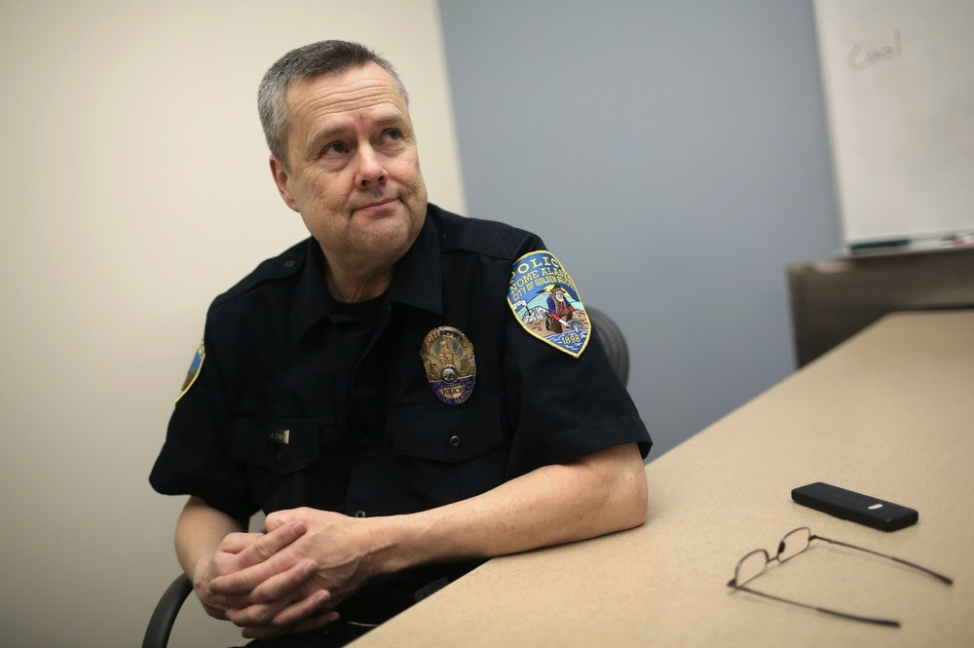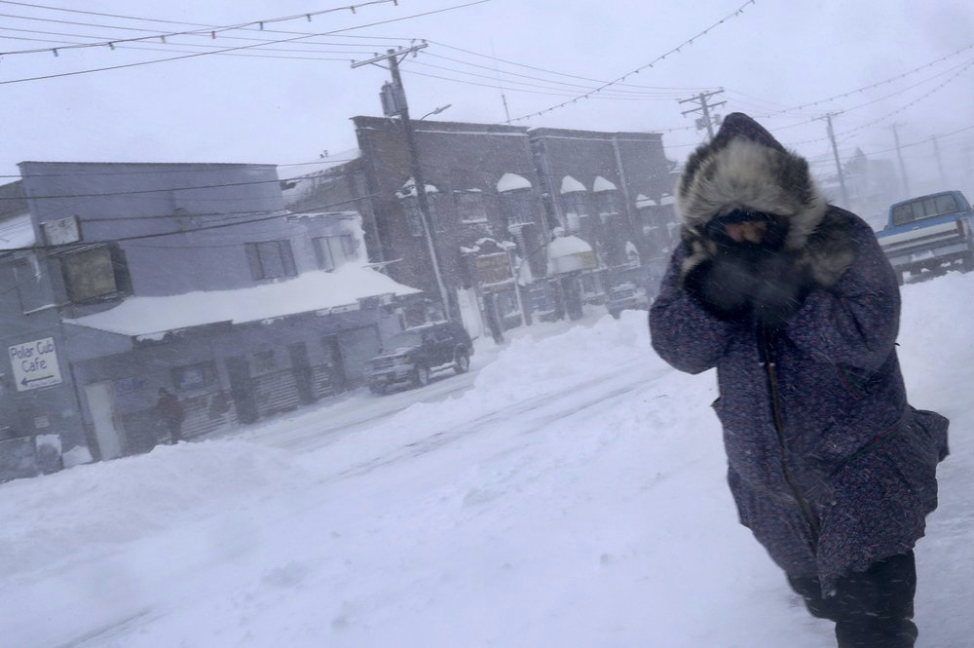
A call comes over Elizabeth Jachim's radio from a fellow officer responding to a woman outside on a cold Nome night. The woman said she'd been sexually assaulted.
"How 56 is she?" Jachim asks, using the police code for 'intoxicated pedestrian.'
"She's highly 56. We didn't get a BrAC (Breath Alcohol Concentration test)," the voice on the radio responds.
Jachim takes the lead in this case as the only officer on duty with sexual assault response training.
"If you can stop by the station and grab the SART kits in case she's capable of getting an exam, and I will go up there and see if I can establish if she is capable of giving one," Jachim says, using the acronym for a Sexual Assault Response Team exam kit. If medical staff deem the woman too intoxicated, she can't legally consent to a SART exam.
The team of officers on duty is among the 11 sworn officers, including an investigator, and an additional two community service officers that make up the Nome Police Department. The department has had a revolving door, with an average retention rate of only two-and-a-half years. They rarely had 8 positions filled. In 2016 the city was down to 5 officers, one of them on medical leave. There was only one patrolman to respond to all calls on any given night. Police and city officials say the high cost of living and relatively low salaries make it hard to recruit and retain talented officers.
In 2018, a community service officer pleaded guilty to punching a woman while on duty. He was fired, but then rehired by the city to work as a dispatcher in the same department.
That added to mounting criticism of police misconduct that reached a boil that summer. The police chief, John Papasodora, decided to retire. His boss, the city manager, was facing a growing scandal after a woman went public with sexual harassment allegations. He was getting ready to step down, but before he did, he installed a new police chief without any public process or input from residents.
Bob Estes took over as Nome police chief in September. He previously worked at the Chesterfield County Police Department just outside of Richmond, Virginia. He worked for the department for 30 years before retiring in 2010. Shortly after arriving in Nome, he invited three other colleagues, all retired officers from Chesterfield County P.D. He also has almost 40 years of experience in the National Guard Reserve which he said informs his management style.
"Coming in with a military background, as a commander of several units, you always do the audit and bean count when you come in as a new guy or gal," he said in an interview. "That's basically what I'm doing here. And it was my choice to audit additional cases, going back to at least 2005."
When he first came to Nome he met with different local organizations, like the Nome Eskimo Community and the regional tribal authority, Kawerak Inc., and started taking stock of the records behind the papered-over windows of the police station. As part of the internal audit, his team is reviewing at least 460 sexual assault complaints, beginning with more recent cases. Estes said he also sought guidance from other law enforcement agencies, including state troopers and the FBI. He's since brought 76 sexual assault cases to the district attorney. Fifty seven of them were rejected.
Sgt. Jerry Kennon, 75, is one of the three new investigators pouring through old cases. He's also one of Estes' retired colleagues from Virginia. Kennon said very early on in his review he found shoddy procedures going back decades.
"What I'm finding with these is there just were no narratives done to them at all, much less an investigation," Kennon said.
He's looking at calls for service logged into the department's records management system. For each of these, there should be a police report. But some of those reports are simply missing. Others had no follow ups or had evidence that was never submitted to the state lab.
"We're a quarter of the way through them, I would say," Kennon said at the time. "Some of them are really bad, serious cases that were not investigated."
At the same time the investigators are trying to get a handle on past cases, Chief Estes said new cases keep coming in. He is still working toward his goal of having at least two officers on shift at a time.
Even with new officers and a renewed public outreach effort, Estes has an uphill battle convincing a skeptical public that has a long memory about the department's troubled history. Most notably, in 2005, a jury convicted a Nome police officer of murdering a 19-year-old Inupiaaq woman from the village of Unalakleet, south of Nome. Matt Owens shot Sonya Ivanoff, left her naked body next to a service road outside of town, and tried to cover up the crime. Residents had complained to police officials that Owens cruised the streets in his uniform making unwanted sexual advances and picking up young women and even underage girls in his police car. After settling a $500,000 civil suit with Ivanoff's family, the City of Nome quietly paid another $270,00 to settle remaining lawsuits filed by three women who said they were stalked, threatened and sexually assaulted by Owens. Nome police helped solve the Ivanoff case, but many residents complained investigators failed to talk to witnesses and were slow to follow leads. The murder sent shockwaves throughout the region. It also prompted Alaska Native villagers to speak up about their negative experiences with Nome Police. Stories about police interaction with Native residents ranged from indifference to hostility and even physical assault. Two regional Alaska Native organizations called for a federal human rights investigation. The Norton Sound Regional Hospital board cited what it called "discriminatory harassment and excessive force" in the police department and unsolved cases of Alaska Native residents who went missing or turned up dead in Nome. Kawerak, the regional tribal consortium, published a list of 20 unsolved deaths and disappearances of Native people in Nome. There was a department shake-up. In 2005, the city hired a new police chief, Craig Moates, who promised to heal the wounds. Moates met with residents of the surrounding villages and listened to individual complaints. But in the end, there was never an outside investigation of police practices. Moates concluded the allegations of police harassment, abuse and malfeasance could not be substantiated.
The city is on its fourth police chief since then. Complaints continued to fester in that time but didn't reach another breaking point until 2018, when a small group of Alaska Native residents started speaking publicly about the growing number of unsolved sexual assaults. A National Native News analysis found over the past decade, only 8% of all calls to Nome police about sexual assaults resulted in an arrest with charges filed.
Officer Nick Harvey is emblematic of where sexual assault complaints stopped. National Native News spoke to Susie, a woman who called police immediately after she said a man followed her home from a bar and raped her. She doesn't want to be identified because she is afraid of her perpetrator, who was never arrested.
Susie reported her rape to Nick Harvey and another officer in 2013. According to a forensic nurse's notes from medical records Susie released to National Native News, Harvey brought her to the hospital. But then he tried to cancel the rape exam "because the man admitted that he 'had sex' with the patient but that it was consensual. Therefore the officer did not see a need for an exam," the nurse wrote in her report from that night. The nurse did the exam anyway. Harvey declined collecting DNA. Court records show the man had been convicted of 3 prior assaults. Susie remains afraid to come to Nome from her nearby village for necessary medical appointments.
"Honestly, if you look back at a lot of the sexual assaults (investigations) within the police department that that particular officer did, it was always like a no report, 'he said she said' kind of thing," said former Nome Community Services Officer Tomas Paniaataq, who is Inupiaq and a member of the King Island Native Community. He trained under Harvey. He eventually left the department for a job in the Alaska Division of Juvenile Justice. His observation about NPD is backed up by former Nome Sgt. Preston Stotts, who said he was frustrated with shoddy police work and what he called the "good ol boy syndrome" in the department. Stotts said he investigated Lt. Harvey's work on more than one occasion, and that Harvey and others regularly failed to respond to felony calls and sexual assaults. He said he reported his concerns to the police chief and to the city manager. Nothing happened. In fact, Harvey was promoted.
As the city was hiring it's new chief of police in 2018, Bun Hardy went public with the allegations she was drugged at a Nome bar and raped, saying police failed to investigate. She blames Lt. Harvey's lack of follow-through as the reason her case languished and died. For one, she says he never delivered on his promise to get a Glass warrant, a complaint levelled by several other sexual assault accusers.
"You know if Nick (Harvey) would have done his job and got…that Glass warrant, and gotten their (alleged perpetrators') phones and gotten the video that would make my case that much more stronger," Hardy said. "But since it's all gone… that's why the D.A. is not going forward with charges, because…he doesn't have any hard evidence."
Nick Harvey declined to be interviewed for this story. He's now a deputy clerk at the Nome courthouse.
Estes admits his review of old sexual assault cases may not produce results right away.
"These cases are going to absolutely take time to reopen because if it's cases that are a few years ago then we're gonna have to reopen, find victims, witnesses, possible suspects in these cases, and gathering the evidence again," Estes said. "But, again, that's what we're here for."
The Alaska state Attorney General denied a public records request for information indicating why 57 of the 76 sexual assault cases Estes submitted were declined. He argued that the information is protected under attorney-client privilege.
A National Native News analysis finds that between 2010 and 2017, only 25 cases of sexual assault in Nome made it to court. Who, or what, prevented prosecution remains a secret guarded by police and the state Attorney General.
Nome residents also encounter barriers getting information from police, even for their own cases.
Bun Hardy, Diedre Levi and Susie all requested copies of the police reports pertaining to their alleged sexual assaults. None has gotten any records yet. Police Chief Estes noted that many older records were discarded during the move to a new police station in 2009, but doesn't know how or why. At least one assault survivor who spoke to National Native News discovered in February that all traces of her case, including forensic material, were simply gone.
John Handeland is Nome's acting city manager. He stepped in to fill the position when Tom Moran resigned and then left the state facing sexual harassment accusations.
Handeland encouraged people to come to his office and talk to him personally if they aren't comfortable going to police or to other city leaders.
"A city council meeting and public comment is not the proper place for an ongoing conversation back and forth," Handeland said. "It's a business meeting to take care of items on the agenda."
Susie is still waiting to hear back from either the new chief or Handeland, who told National Native News in February he would personally help her get a copy of her police report. It's not clear whether a report even exists.
The Alaska Police Standards Council oversees police certification. State regulations require police departments to report instances of 'sustained misconduct' to the council within 30 days. Their records show the council has investigated only one Nome officer over the past 13 years. That was Lance McElroy, who quit the department in November 2018 while under investigation pending disciplinary action. The council only heard of this case after Chief Estes took over. McElroy surrendered his police certification in May, which bars him from working as an officer in Alaska. The council did not investigate Nick Harvey, saying only that they received a report from Nome police in late June about one officer who left the department, but the case didn't rise to the level of decertification.
Since Estes took over as chief, there's been a quiet shake-up. At least five officers have left the department, including Nick Harvey and Lance McElroy. Estes hasn't publicly said who the officers are or why any of them are no longer working there.
Sergeant Kennon said that unless the officers are charged with a crime, their names won't be made public.
"In going and giving out their names, what you have to remember about that is that some of these guys have families and they have kids and we're not going to go and give out their name to the public and then all of a sudden we have some form of retaliation against that officer's family," Kennon said. "From what I'm seeing everybody is going to know anyway that something happened."
He said it's not up to the Nome Police Department to determine whether those officers can go work in another city or state.
"So if we were in a situation where we found that these guys were doing things that went against our policy, against integrity, all of those things, they would not be working at the (Nome) police department anymore," Kennon said. "That's how they are held accountable."
Chief Estes' apparent shake up of personnel and his audit of past cases gives many people in this small city hope. But at the same time, Estes has indicated a continued focus on certain issues that worry residents. Tactics that might work elsewhere offer little promise here. Putting police officers in schools for one. Some Alaska Native parents fear it will only criminalize young Native people. Another is a focus on alcohol.
In the first months of his tenure, Estes told National Native News that he believed Nome's biggest public safety issue is what he calls its "huge inebriation problem." The police release a report every week that's published in the Nome newspaper. In bold letters across the top, each column indicates the rate of alcohol use relative to all police calls. They're put under the vague heading "alcohol involved". The number is usually high. It can be 80 percent or more. Those types of numbers, says Sgt. Kennon, are different than his old department in Virginia:
"When I worked our rape cases and homicide cases before, quite a few times you wouldn't see alcohol involved in it," Kennon said. "But I'm telling you, here it is completely the opposite way around for me. All the reports that I read, all the ones that I see, alcohol is involved. Do they have to be intoxicated? No. You just see that there. They're involved in it and it's not just a suspect it's the victims too. Here, they call it being blacked out. I've never experienced that myself but it definitely seems to be that alcohol is a thriving issue to go along with the sex offenses."
But for some long time residents alcohol has become code for "Alaska Native".
"I'm really exhausted with hearing terms like 'street drinkers,' or 'homeless people' or 'Alaska Native drunk,'" said Lisa Ellanna. She's Inupiaq and a resident of Nome. She's part of a core group of people fighting an uphill battle to change the narrative out of city hall, the police department, and in the media. "Those kind of terms really work to perpetuate really negative racial stereotypes and can really validate people's innocently ignorant assumptions about Alaska Native people. And that's very very concerning."
Highlighting statistics on how many police calls involve alcohol leave important details up to the imagination. Was a suspect drinking? A victim? Was it one drink, two drinks?
For Ellanna, this does little to inform any solution.
"The use of substances is a symptom," she said. "It's people numbing out because they've experienced some trauma, or many traumas. Or many generations of trauma."
The correlation between alcohol and violence is inconclusive, said Andre Rosay, associate dean of the College of Health at the University of Alaska Anchorage. He previously headed up the university's Justice Department. He's also the author of a 2017 report on the prevalence of violence for Alaska Native men and women. The study does not mention alcohol.
"Is it a cause of violence? We tend to believe that it is not a cause," Rosay said. "Yes it does tend to co-occur, but we don't believe that it's a cause of the violence. If we were to eliminate or address the alcohol issue, the violence would still be there. And so we must do more than that in order to prevent violence."
If a person reporting a sexual assault shows signs of intoxication, it can work against them many ways. It influences decisions by police, medical staff and the prosecuting attorneys.

Education Resource
Meet the Journalist: Victoria Mckenzie
Officials and citizens in Nome, Alaska, a remote city in western Alaska's Bering Strait region, are...










